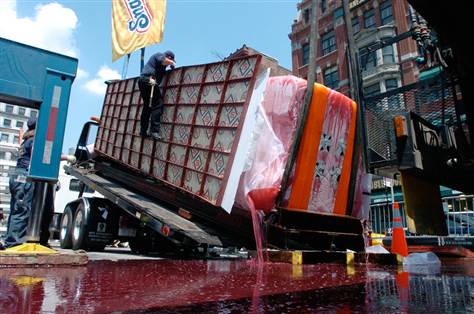Disaster off a Stick
In 1905, an eleven-year-old boy named Frank Epperson made a mistake. The Oakland, California kid had been stirring some powdered soda mix into a glass of water but, like kids often do, didn’t clean up after himself properly. He left the glass — mixed soda powder and stick still in it — outside overnight. And when he woke up in the morning, he woke up to a surprise. Temperatures dropped more than expected and, as History.com explains, “the soda mixture was frozen solid.” So, History.com continues, Epperson “ran the glass under hot water and removed the ice pop using the stick as a handle.” He took a taste — and it was great. When Epperson grew up, he decided to make his discovery into a commercial product, and the Popsicle was born.
A century later, this happened:

That picture (via NBC News) comes from New York City’s Union Square. Inside that truck is a big Popsicle — a generic version, created by beverage company Snapple — which, while frozen, weighed 17.5 tons and would have stood 25 feet (about 7.5m) tall. The huge Popsicle was (obviously, one hopes) a publicity stunt — Snapple had a new flavor out, strawberry-kiwi, which it wanted to promote. With the icy concoction seen above, Snapple was trying to set the world record for the world’s largest frozen fruit drink.
But, just like Epperson misestimated the temperature in 1905, Snapple goofed in 2005. Unfortunately for those in the area, Snapple’s error went the other direction. The frozen strawberry-kiwi juice was put on a truck in Edison, New Jersey, but when workers in Manhattan began to remove it from the freezer truck, a large amount of the frozen brick was no longer frozen. As you can see above, the 80-degree day turned some of the ice into a river of juice which flowed from the truck and into the public square, creating a scene reminiscent of Ghostbusters II. Snapple’s workers stopped the ice block exhibition before it started — the truck’s flatbed only reached about a 25-degree angle before they gave up.
The river, however, didn’t abate so quickly. As a Guinness Book of World Records observer told the New York Daily News (via the above-linked NBC News article), “what was unsettling was that the fluid just kept coming. It was quite a lot of fluid. On a hot day like this, you have to move fast.” Or, at least walk away — the gathered crowd walked away in a mostly orderly fashion.
The authorities moved faster. Per the New York Times, the New York City police scanners rang out with an alert: “A giant Popsicle being displayed by Snapple has melted in the heat and sun and spilled all over 17th Street. F.D. on scene attempting to wash down the roadway — sticky goo all over the area.” The fire department broke out the hoses, closed down some streets, and washed away the sugary liquid. But unfortunately, the damage was already done. According to Gothamist, “one woman who fell in the hazardous goo was rushed to the hospital with a badly sprained ankle, and three cyclists…were catapulted off their bikes.”
Snapple agreed to pay for the city for the clean-up (and probably paid for some medical bills and new bicycles, too).
Bonus fact: The underside of Snapple’s bottle caps are adorned with something Snapple calls “Real Facts,” which are real facts, they claim. You can browse some of the “Real Facts” on Snapple’s website, here, but please don’t take the underside of a bottle cap as a credible source. Many of them aren’t quite right. In 2013, the Atlantic fact-checked many of the “Real Facts,” finding that “some are true, some are outright false, and plenty others are incomplete or ambiguous to the point of absurdity.” Snapple has removed most of the facts called out by the Atlantic, but even a cursory glance shows more errors. (Oh, and if anyone reading this works for Snapple and wants some real “Real Facts,” I know a guy.)
From the Archives: Ice Scream: Where ice cream headaches come from.
Related: A case of strawberry-kiwi Snapple. Freeze in super-large quantities at your own risk.
